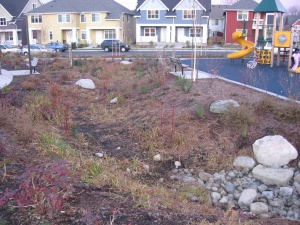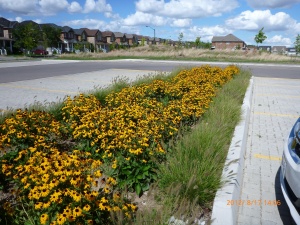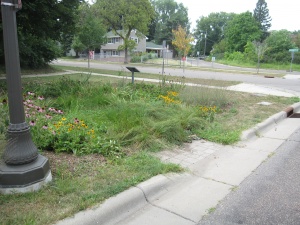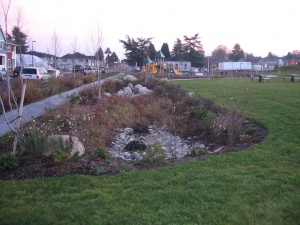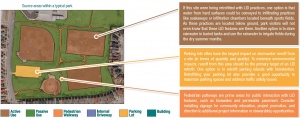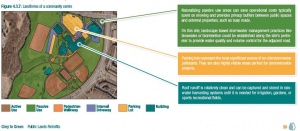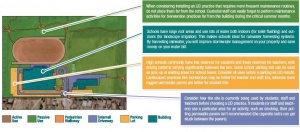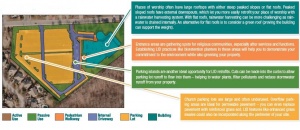Difference between revisions of "LID opportunities on public land"
Kyle menken (talk | contribs) m |
Kyle menken (talk | contribs) |
||
| Line 9: | Line 9: | ||
[[File:Example4.jpg|thumb|A [[no-mow]] zone is a landscape alternative that does not require construction activities. (Source: Aquafor Beech)]] | [[File:Example4.jpg|thumb|A [[no-mow]] zone is a landscape alternative that does not require construction activities. (Source: Aquafor Beech)]] | ||
| − | Starting with small-scale projects is a good strategy to increase public interest in LID practices, gauge municipal support, and gain retrofit experience. Small-scale projects include retrofitting your site with landscape alternatives, rain barrels, enhancements of existing swales, or using pollution prevention strategies and practices. | + | Starting with small-scale projects is a good strategy to increase public interest in LID practices, gauge municipal support, and gain retrofit experience. Small-scale projects include retrofitting your site with [[Landscape alternatives|landscape alternatives]], rain barrels, enhancements of existing swales, or using [[Pollution prevention|pollution prevention]] strategies and practices. |
Small-scale projects require fewer resources and a smaller project budget: | Small-scale projects require fewer resources and a smaller project budget: | ||
*They do not require integration into capital works projects | *They do not require integration into capital works projects | ||
Revision as of 14:40, 19 December 2017
Small-scale and large-scale projects[edit]
The scale of your LID project will largely determine how to proceed. While you can usually complete small-scale LID projects with in-house expertise and resources, large-scale projects require external support from consultants and contractors.
Small-scale projects[edit]
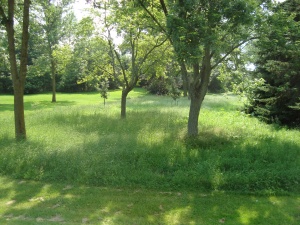
Starting with small-scale projects is a good strategy to increase public interest in LID practices, gauge municipal support, and gain retrofit experience. Small-scale projects include retrofitting your site with landscape alternatives, rain barrels, enhancements of existing swales, or using pollution prevention strategies and practices. Small-scale projects require fewer resources and a smaller project budget:
- They do not require integration into capital works projects
- Engineering consultants are not required
- Contractors may not be not required
- External approvals are not required
- Consultation with the public is limited
Due to less financial commitment, it can be easier to build colleague support and to gain supervisor approval for small-scale projects. However, small-scale projects like landscape alternatives and pollution prevention may not be easily identified as LID practices by the public. Your project team should consider establishing educational signage to inform the public.
Large-scale projects[edit]
Large-scale projects require significantly more effort, budget and staff than small-scale projects. Large-scale LID practices include:
- Bioretention
- Enhanced grass swales
- Bioswales
- Perforated pipe systems
- Permeable pavement
- Soakaways
- Infiltration chambers
- Rainwater harvesting
- Prefabricated modules
- Green roofs
Consider a large-scale project if your municipality, school or place of worship would like to be a leader in sustainability. Large-scale projects are often highly visible and attract more public attention. Large-scale projects may also be the only solution to site-specific challenges. For example, if the parking lot on your site does not have existing stormwater controls, small-scale projects are not likely to fully achieve compliance with water quality and quantity objectives. Consider using an infiltration chamber or bioswale project to meet those objectives. Before starting a large-scale retrofit project, consider the following distinctions that set these retrofits apart from small-scale projects.
Integration with capital works programs[edit]
Most large-scale LID retrofits must function with existing site infrastructure, such as storm sewers, catch basins, and pavement systems. The construction of large-scale LID practices often requires these systems to be removed, exposed, or replaced. The best time for this type of project to occur is when an infrastructure replacement or rehabilitation project is already planned.
When LID retrofits are worked into other construction projects, such as parking lot repaving, or grading or drainage improvements, there can be substantial cost savings. Whether big or small, every municipality spends relatively large sums of money and substantial time planning for major capital projects. This includes redevelopment of public building and spaces. Many communities who have undertaken retrofits recognize that even if a relatively small portion of the project funds goes towards LID retrofits, they can retrofit large impervious surfaces and avoid new stormwater management infrastructure projects.
Municipal facility rehabilitation is typically forecast well in advance of the project. Parking lot paving is typically worked into municipal budgets based on expected life cycle and observed wear. As such, funds may be set aside prior to the project planning phases. Long-term forecast budgets may also be available for site revitalizations or expansions. These budget forecasts provide opportunities to compare the capital and life-cycle costs and benefits of the conventional construction project and LID retrofit.
Regulatory compliance[edit]
The objectives, technologies, and standard practices associated with stormwater management are constantly evolving. It is unlikely that the stormwater management practices on your site meet modern industry standards. When you are making changes to your site, it is important to stay ahead of the regulations. Your school may not be required to improve on-site stormwater management infrastructure, but those retrofits can be beneficial and save money and time over the long term. Consider both current and future water regulations which may affect your property. Consulting with your municipality will help you determine if LID retrofits can reduce taxes or prevent costly upgrades required at a later date.
Involvement of consultants and contractors[edit]
Consultants are required for large-scale retrofit projects, specifically for the final screening of options, pre-design, detailed design, tender and contract documents, construction supervision and administration, and assumption and verification. Site contractors are also required for large-scale LID retrofits.
Ideally, contractors should be pre-qualified based on previous experience with similar LID projects.
Intensive public consultation[edit]
Stakeholders must be closely involved in the retrofit process for large-scale LID projects. These projects have longer construction windows, may have significant impacts on long term public use patterns of the site and will have significantly higher costs. Gaining public insight before LID implementation can help address public concerns and information gaps, as well as identify public supporters and champions. Public consultation can help designers tailor the project to address community concerns and values.
External approvals[edit]
Large-scale retrofits may require a variety of approvals at the municipal, watershed, provincial, and/or federal level. Since LID is still relatively new, you may encounter policies or bylaws that present barriers to LID retrofit projects. Alternatively, the municipality may have to amend or enforce some policies and bylaws to facilitate the implementation of LID projects on your site.
Parks[edit]
Parks range from simple parcels of municipal property to complex outdoor recreational facilities that include parking, sidewalks, trails, sports fields, field houses, operations facilities and washrooms. Each distinct area of your site can be a source for runoff (referred to as a ‘source area’). Target these areas when introducing LID in your park.
Targeting hard surfaces[edit]
Hard surfaces like parking lots and internal driveways are the most obvious targets for both stormwater quality and water balance improvements. These features produce more runoff than any other area on your site. Runoff from parking lots and driveways is typically more polluted than other source areas. Common water quality concerns include sand and salt from winter de-icing operations, hydrocarbons (gasoline) and heavy metals from vehicle breakdowns.
Runoff from vegetated areas of parks will be relatively clean and more closely matches the natural water balance. On municipal park properties, hard surfaces are usually located adjacent to pervious areas such as lawns, gardens or naturalized areas. This makes parks an ideal location for a LID retrofit. Where grading allows, you can construct bioswales and bioretention areas in these green areas to pre-treat water prior to infiltration.
You can also design parking surfaces and internal roadways as infiltration systems using permeable pavement. This retrofit strategy can be combined with other LID practices. Pathways paved with permeable paving are another LID option for your park. They reduce runoff volumes and encourage on-site infiltration. Exfiltration trenches are a viable option on many parks sites as well, as they provide an alternative to conventional conveyance systems (such as storm sewers). They encourage infiltration from hard surfaces and can be used to convey water to other LID features.
Accepting drainage from off-site areas[edit]
Does municipally owned land drain into your retrofit site? If so, this is an opportunity to provide stormwater controls for these areas. Roads are the most common source of runoff from external properties into parks. Treating municipal road runoff in a park requires planning input from municipal roads department staff. For these projects, the team must understand how all road activities, including winter maintenance and potential roadwork, will affect the operation of LID practices in the park.
Inter-municipal transfer of funds[edit]
Integrating LID practices into the municipal stormwater management framework may require a change in how municipal funds are managed. Traditional stormwater management maintenance resources and funds may have to be transferred to a more landscape-based stormwater management maintenance program. Instead of infrequent but expensive stormwater management pond sediment removal operations, time and resources would be spent on more frequent but inexpensive maintenance projects, including pruning and weeding bioretention practices or sweeping permeable pavement. Municipalities generally have the required staff and infrastructure within departments (e.g. arborists and horticulturalists in parks departments) to manage the maintenance of LID measures. However, funding this maintenance may require a transfer of funding and additional training. The federal Gas Tax Fund (GTF) is another funding option for LID retrofits. This federal transfer provides long-term funding for municipalities to build and revitalize public infrastructure. Up to 30% of a municipality's yearly GTF allotment can be used for stormwater management.
Source Areas[edit]
The best LID option for your site will depend what types of source areas are present. Source areas may include:
- Active use areas
- Passive use areas
- Pedestrian walkways
- Internal driveways
- Parking lots
On park sites, pollution prevention is often associated with changes to operations and maintenance practices and has not been included in the table below. Options and implementation strategies for a few of these source areas will give you some ideas for your park site.
| Source area | Permeable paving | Bioretention | Enhanced grass swales | Bioswales | Infiltration trenches and chambers | Exfiltration trenches | Landscape alternatives | Prefabricated modules |
|---|---|---|---|---|---|---|---|---|
| Active use area | ** | o | * | * | ** | * | o | o |
| Passive use area | o | ** | ** | ** | ** | ** | ** | ** |
| Pedestrian walkway | ** | ** | ** | ** | ** | * | * | o |
| Internal driveway | ** | ** | ** | ** | ** | ** | o | * |
| Parking lot | ** | ** | ** | ** | ** | ** | o | ** |
Making it happen: Approaches to getting LID into parks[edit]
The scale of your LID project will largely determine how to proceed. While you can usually complete small-scale LID projects with in-house expertise and resources, large-scale projects require external support from consultants and contractors.
Small-scale projects[edit]

Starting with small-scale projects is a good strategy to increase public interest in LID practices, gauge municipal support and gain experience. Small-scale projects include retrofitting your park with landscape alternatives, rain barrels, or by using pollution prevention strategies and practices.
Small-scale projects require fewer resources and a smaller project budget:
- They do not require integration into capital works projects
- Engineering consultants are not required
- Contractors may not be not required
- External approvals are not required
- Consultation with the public is limited
Due to less financial commitment, it can be easier to build colleague support and to gain supervisor approval for small-scale projects. However, small-scale projects like landscape alternatives and pollution prevention may not be easily identified as LID practices by the public. Your project team should consider establishing educational signage to inform the public.
Large-scale projects[edit]
Large-scale projects require significantly more effort, budget, and staff than small-scale projects. Large-scale LID practices include:
- Bioretention
- Enhanced grass swales
- Bioswales
- Perforated pipe systems
- Permeable pavement
- Soakaways
- Infiltration chambers
- Rainwater harvesting
- Prefabricated modules
Consider a large-scale project if your municipality or department would like to be a leader in sustainability. Large scale projects are often highly visible and attract more public attention. Large-scale projects may also be the only solution to site-specific challenges. For example, if the parking lot on your site does not have existing stormwater controls, small-scale projects are not likely to fully achieve compliance with water quality and quantity objectives. Consider using an infiltration chamber or bioswale project to meet those objectives.
Before starting a large-scale retrofit project, consider the following distinctions that set these retrofits apart from small-scale projects.
Integration with capital works programs[edit]
Most large-scale LID retrofits must function with existing site infrastructure, such as storm sewers, catch basins and pavement systems. Constructing large-scale LID practices often requires these systems to be removed, exposed or replaced. Planned infrastructure replacement or rehabilitation projects provide opportunities for implementing LID practices. For example, if a planned project requires removing existing pavement, infiltration chambers, permeable pavement or bioretention can be incorporated. Budget and resources already set aside for infrastructure projects can be set aside for a retrofit project including replacement existing infrastructure.
Involvement of consultants and contractors[edit]
Consultants are required for large-scale retrofit projects, specifically for the final screening of options, pre-design, detailed design, tender and contract documents, construction supervision and administration, and assumption and verification. Site contractors are also required for large-scale LID retrofits.
Ideally, contractors should be pre-qualified based on previous experience with similar LID projects.
More intensive public consultation[edit]
Stakeholders must be closely involved in the retrofit process for large-scale LID projects. These projects have longer construction windows, may have significant impacts on long term public use patterns of the park, and will have significantly higher costs. Gaining public insight in advance of LID implementation can help address public concerns and information gaps, as well as identify public supporters and champions. Public consultation can help designers tailor the project to address community concerns and values.
External approvals[edit]
Large-scale park retrofits may require a variety of approvals at the municipal, watershed, provincial and/or federal level. Since LID is still relatively new, you may encounter policies or bylaws that present barriers to LID retrofit projects. Alternatively, the municipality may have to enforce some policies and bylaws to facilitate the implementation of LID projects within parks.
Municipal facilities[edit]
Each distinct area of your site can be a source for runoff (referred to as a ‘source area’). Target these areas when introducing LID in your municipal facility.
Targeting hard surfaces[edit]
Municipal facilities have large parking lots to accommodate public demand. Parking areas represent the most significant source of pollutant loading from these sites and contribute significantly to increased runoff rates in comparison to natural conditions. Parking lots include areas for parking, areas for driving, and islands or landscape planters used for calming traffic, directing vehicles and improving pedestrian safety.
LID practices can be incorporated into all areas of a parking lot. You can use bioretention in parking lot islands and along the lot perimeter. Standard curbs with small cut-outs (called ‘curb cuts’) can allow water to easily enter biorentention practices while also preventing damage from cars.
Bioswales are excellent options in parking lot islands or along lot perimeters. Parking lots with existing perimeter ditching are ideal for bioswale integration due to their extended continuous flow path.
Prefabricated modular infiltration chambers are gaining acceptance for their easy integration with parking lot functions. These subsurface systems are typically installed over a coarse granular reservoir to provide storage and allow infiltration into native soils. Infiltration chambers under conventional asphalt system work well on sites where parking demand and other site uses do not allow space for a stormwater feature.
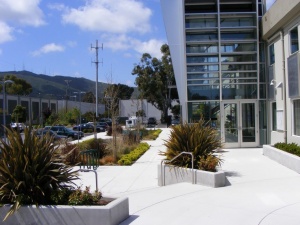
Permeable pavements are also an option in large municipal parking lots. Pervious concrete, permeable interlocking concrete pavers, and porous asphalt can detain stormwater and increase infiltration.
Municipal facilities provide excellent opportunities for integrating rainwater harvesting systems. Rainwater harvesting systems have two requirements: an area for catchment of relatively clean runoff and a nearby demand for water usage. Municipal facilities often have large rooftop areas producing relatively clean runoff. Installing a cistern internal to the building or buried adjacent to the building can provide a sustainable source of water for site irrigation needs for landscaped areas, recreational fields and indoor use (e.g. flushing toilets and urinals).
Targeting highly visible areas[edit]
If your LID integration strategy involves highly visible LID practices, consider targeting areas with high-volume pedestrian traffic. This can help promote LID's visibility among the public and increase support for future LID projects.
Targeting pollution prevention opportunities[edit]
On some municipal sites, pollution prevention techniques and strategies are the best approaches to mitigating the environmental impact of your site. Retrofits of municipal works yards require a different approach than other land uses discussed in this guide. Works yards do not offer substantial opportunities for public interaction. LID retrofits should focus primarily on reducing pollution generated on-site. Fueling stations, waste storage areas, truck washing stations, sand and salt storage, staging areas and water conveyance features are ideal for pollution prevention.
Source areas[edit]
The best LID option for your site will depend what source areas are present. Types of source areas include:
- Active use areas
- Passive use areas
- Pedestrian walkways
- Internal driveways
- Parking lots
On municipal sites, pollution prevention is often associated with changes to operations and maintenance practices and has not been included in the table below.
| Source area | Permeable pavements | Bioretention | Enhanced grass swales / bioswales | Green roofs | Soakaways and infiltration chambers | Perforated pipe systems | Rainwater harvesting | Landscape alternatives | Prefabricated modules | Pollution prevention |
|---|---|---|---|---|---|---|---|---|---|---|
| Active use area | ** | ** | ** | o | ** | * | o | * | o | ** |
| Passive use area | o | ** | * | o | ** | ** | o | ** | ** | ** |
| Pedestrian walkway | ** | ** | ** | o | ** | * | o | * | * | ** |
| Internal driveway | ** | ** | ** | o | ** | ** | o | o | ** | ** |
| Parking lot | ** | ** | ** | o | ** | ** | o | o | ** | ** |
| Building | * | * | * | ** | ** | * | ** | o | o | ** |
Schools[edit]
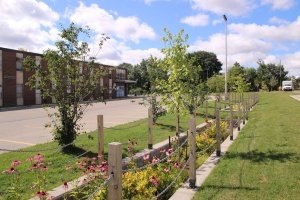
Each distinct area of your site can be a source for runoff (referred to as a ‘source area’). These areas should be targeted when introducing LID at your school.
Targeting hard surfaces[edit]
Parking areas represent the most significant source of pollutant loading from school sites and contribute significantly to increased runoff rates in comparison to natural conditions. Parking lots of all sizes can be targeted for permeable pavement retrofits. As an added benefit, permeable pavement systems have a longer lifespan compared to conventional asphalt. High schools often have large parking lots where the capacity outweighs the demand. These areas represent opportunities to install bioswales or bioretention areas in parking lot islands. Standard curbs with small cut-outs (called ‘curb cuts’) can allow water to easily enter biorentention practices while also preventing damage from cars. Often the existing drainage patterns and catch basin locations can be preserved and integrated into the design. These practices will also function to improve pedestrian safety and calm traffic. Other types of infiltrating practices like infiltration chambers are gaining acceptance for their easy integration with parking lot functions. These subsurface systems are typically installed over a coarse granular reservoir to provide storage and allow infiltration into native soils. Infiltration chambers under conventional asphalt systems work well on sites where parking demand does not allow space for a stormwater feature. Grassed areas adjacent the parking lots are ideal areas to implement bioswales or bioretention areas. Perforated pipe systems may also work in areas adjacent to parking lots.
Roof options[edit]
Schools typically have large flat roofs that produce a significant amount of runoff that is drained internally via rain leaders. Schools also consume large quantities of water for flushing toilets and urinals. Rainwater harvesting systems can tackle both of these issues by intercepting this rooftop runoff and re-using it for toilet flushing as well as outdoor irrigation. This option has the benefit providing an ongoing financial benefit through reduced water bills. Roof runoff can also be directed to soakaways located on passive use areas around the building. As this runoff comes into contact with fewer hard surfaces, it produces better quality runoff than roads and does not require pretreatment devices. Green roof retrofits are another retrofit option for schools. When applying for external funding from organizations, highlight the fact that green roofs reduce energy usage by providing insulation during the winter and evaporative cooling during the summer.
Pollution prevention (P2)[edit]
On school sites, P2 strategies and practices, such as modifying de-icing programs and isolating drainage from waste storage areas, can be applied to operations and maintenance activities. Discuss these changes with your school board and operations staff.
School board partnerships with municipalities[edit]
LID practices located on school grounds can also be used to treat stormwater from external properties. These partnership opportunities give schools the potential to create new revenue. Accepting and treating runoff on your existing property can make funds available through: • Contributions to capital projects like parking lot rehabilitations which include rain gardens, permeable pavements, or subsurface infiltration facilities • Ongoing revenues from long-term land leases to accommodate surface or subsurface LID retrofits • Funds for maintenance of on-site LIDs
Regulatory Compliance[edit]
The objectives, technologies, and standard practices associated with stormwater management are constantly evolving. It is unlikely that the stormwater management practices on your site meet modern industry standards. When you are making changes to your site, it is important to stay ahead of the regulations. Your school may not be required to improve on-site stormwater management infrastructure, but those retrofits can be beneficial and save money and time over the long term. Consider both current and future water regulations which may affect your property. Consulting with your municipality will help you determine if LID retrofits can reduce taxes or prevent costly upgrades required at a later date. The table below identifies the LID practices that are common, possible and unlikely options for the source areas that you are likely to find on your school site. These source areas are: • Active use area • Passive use area • Pedestrian walkway • Internal driveway • Parking lot An aerial photo of a school property with each of these source areas accompanies Table 5.3.1. Options and implementation strategies for a few of these source areas will give you some ideas for your site. This guide provides two tiers of LID retrofit projects The scale of your LID retrofit project will largely determine how you will proceed with the retrofit process. You can usually complete small-scale LID projects with in-school expertise and resources. Large-scale projects will require external support from consultants and contractors. It is often difficult to ask students or teachers to maintain LID practices during the summer break. Include summer operations staff time in your budget during the planning process.
Small-scale projects[edit]
Starting with small-scale projects is a good strategy to increase interest within your school, determine what support is available from stakeholder groups (parent council, school board, administration and operations) and gain retrofit experience. Small-scale projects include retrofitting your school property with landscape alternatives or rain barrels, or using pollution prevention strategies and practices. Small-scale projects require fewer resources and require a smaller project budget because: • They do not require integration into long-term infrastructure replacement and rehabilitation plans • Engineering consultants are not required • Contractors may not be required • External approvals are not required • Consultation with the public is limited Due to the smaller financial commitment, it can be easier to build colleague and school board support for small-scale projects. A successful small-scale LID retrofit project on your school property can be a good indication that you are ready to take on a more intensive retrofit project. You now know the resources that are available and understand the internal municipal processes required to move a LID project from planning to finished product.
Large-scale projects[edit]
Large-scale projects require significantly more effort, budget, and staff than small-scale projects. Large-scale LID retrofits include:
- Bioretention
- Enhanced grass swales
- Bioswales
- Perforated pipe systems
- Permeable pavement
- Soakaways
- Infiltration chambers
- Rainwater harvesting (excluding rain barrels)
- Prefabricated modules
- Green roofs
Consider a large-scale project if your school board is striving to be a leader in sustainability. Large-scale projects are often highly visible and attract more public attention. They may also be the only solution to site-specific challenges. For example, if the parking lot of your site does not have existing stormwater controls, small-scale projects are unlikely to fully achieve compliance with water quality and water quantity objectives. Instead, use a large-scale project like an infiltration chamber or bioswale. Before starting a large-scale retrofit project, consider the following distinctions that set these retrofits apart from small-scale projects.
Integration with long-term infrastructure replacement and rehabilitation plans[edit]
Most large-scale LID retrofits must function with existing site infrastructure, such as storm sewers, catch basins, and pavement systems. The construction of large-scale LID practices often requires these systems to be removed, exposed, or replaced. The best time for this type of project to occur is when an infrastructure replacement or rehabilitation project is already planned. Like other large public sites, schools typically have maintenance programs that take into consideration the expected life cycle of critical site components, including parking lots and roofs. To save construction costs, incorporate LID retrofits into these projects and share construction material, construction equipment, staff resources, and time. For example, installing bioretention, infiltration chambers, or permeable pavement in a parking lot will require the existing pavement to be removed. Budget and resources that have been set aside for a parking lot replacement could be transferred to a retrofit project.
Involvement of consultants and contractors[edit]
Consultants are required for large-scale retrofit projects, specifically for the final screening of options, pre-design, detailed design, tender and contract documents, construction supervision and administration, and assumption and verification. The consultant selection process is described in Chapter 7. Site contractors are also required for large-scale LID retrofits. Contractors should be pre-qualified based on previous experience with similar LID projects. Remember, the contractor with the lowest bid does not necessarily deliver the best product. Refer to Chapter 7 for tips on how to select the right contractor for your project.
More intensive public consultation[edit]
Stakeholders must be closely involved in the retrofit process for large-scale LID projects. These projects have longer construction windows, larger costs, and will more significantly affect the use patterns of the property. Large-scale projects are also more complex systems that require continued inspections, operations, and maintenance to achieve continued success. All stakeholder groups must be aware of the long-term project needs before implementation.
External approvals[edit]
Large-scale retrofits may require a variety of approvals at the municipal, watershed, provincial, and/or federal level. Since LID is still relatively new, you may encounter policies or bylaws that present barriers to LID retrofit projects. Conduct a review of relevant municipal and school board policies prior to implementing a large-scale retrofit. School board policies may require amendments to move forward.
Next Steps[edit]
After reading this section you should know how to select the right LID practice for your site. You should also be familiar with the details you need to consider before undertaking an LID retrofit. For further guidance on implementing and constructing LID practices, please refer to Chapters 7-9. These chapters provides the next steps for you to implement your LID project, including building the project team, creating a design, getting approvals, construction, certification and guidance on operations and maintenance of LID practices.
| Source area | Permeable pavement | Bioretention | Enhanced grass swales / bioswales | Green roofs | Soakaways and infiltration trenches | Perforated pipe systems | Rainwater harvesting | Landscape alternatives | Prefabricated modules | Pollution prevention |
|---|---|---|---|---|---|---|---|---|---|---|
| Active use area | ** | ** | ** | o | ** | * | o | * | o | ** |
| Passive use area | o | ** | * | o | ** | ** | o | ** | ** | ** |
| Pedestrian walkway | ** | ** | ** | o | ** | * | o | * | o | ** |
| Internal driveway | ** | ** | ** | o | ** | ** | o | o | * | ** |
| Parking lot | ** | ** | ** | o | ** | ** | o | o | ** | ** |
| Building | * | * | * | ** | ** | * | ** | o | o | ** |
Places of worship[edit]
Each distinct area of your site can be a source for runoff (referred to as a ‘source area’). One or more of these areas should be targeted when introducing LID at your place of worship.
Targeting hard surfaces[edit]
Hard surfaces such as parking lots are a great opportunity to implement LID. Parking lots are the main source of runoff and represent the most significant source of stormwater pollutants coming from your site. Parking lots at places of worship are typically busy only on select days of the week when groups gather for prayer or other community activities. Due to this intermittent schedule, parking lots at these facilities are often rented for other purposes during times of low usage. On sites where peak demand does not approach the total capacity of the lot, consider reducing the parking surface. Retrofit options for these large parking lot areas include permeable pavement, bioswales and bioretention areas. A benefit of permeable pavement systems is that they often have a longer lifespan than conventional infrastructure. The freeze-thaw cycle of the Ontario climate is tough on pavement. Frost heaving and slumping can cause cracks and potholes because of the expansion and contraction of water. The expected lifespan for conventional asphalt pavement in a northern climate, such as Ontario, is approximately 15 to 20 years. A well-maintained porous asphalt system can last for over 30 years, and permeable interlocking concrete pavers can have a design life of 20 to 25 years or greater. Using LID techniques to manage stormwater can also eliminate or reduce the need for an on-site storm sewer system. By eliminating piping, failure points in the pavement, such as areas around catch basins and manholes, can be eliminated. A design that does not use storm sewers also negates the need to replace on-site piping, thereby saving long-term infrastructure replacement costs. Prefabricated modular infiltration chambers are gaining acceptance because they are easy to integrate with parking lot functions. These subsurface systems are typically installed over a coarse granular reservoir to provide water storage and allow infiltration into native soils. Infiltration chambers under conventional asphalt systems work well on sites where parking demand does not allow space for a stormwater feature.
Landscaped areas[edit]
Landscaped or lawn areas adjacent to the parking lot or building present opportunities for implementation of LID practices such as bioswales and bioretention areas. These areas typically accept runoff from nearby hard surfaces and provide water quality and water balance benefits.
Roof options[edit]
Rainwater harvesting systems can be simple or complex depending on the architecture and roof drainage patterns of your building. Many places of worship have peaked roofs with piping to convey water from the rooftop. If your site is set up this way, it can be easy to integrate harvesting systems into the landscape surrounding your building. Roof runoff can also be directed to soakaways located on passive use areas around your building. Due to the relatively good quality of this runoff, pre-treatment devices are not required.
Source Areas[edit]
The LID option that best fits your site will depend what types of source areas are present. Types of source areas include:
- Active use area
- Passive use area
- Pedestrian walkway
- Internal driveway
- Parking lot
On park sites, pollution prevention is often associated with changes to operations and maintenance practices and has not been included in Table 6.3.1. An aerial photo of a park with each of these source areas accompanies Table 6.3.1. Options and implementation strategies for a few of these source areas will give you some ideas for your park site.
The scale of your LID retrofit project will largely determine how you will proceed. You can usually complete small-scale LID projects with in-house expertise and resources. Large-scale projects will require external support from consultants and contractors.
Small-scale projects[edit]
Starting with small-scale projects is a good strategy to increase interest within your community, determine if support is available from stakeholder groups and gain retrofit experience. Small-scale projects include retrofitting your property with landscape alternatives, rain barrels or using pollution prevention strategies and practices.
Small-scale projects require few resources and a small project budget because:
- They do not require integration into capital works projects
- Engineering consultants are not required
- Contractors are not required
- External approvals are not required
- Consultation with the public is limited
Due to the less significant financial commitment, it can be easier to build the case for support for small-scale projects. A successful small-scale LID retrofit project on your property is a good indication that you are ready to take on a more intensive retrofit project. You now know the resources that Large-scale projects Large-scale projects require significantly more effort, budget, and staff than small-scale projects. Large-scale LID retrofits include:
- Bioretention
- Enhanced grass swales
- Bioswales
- Perforated pipe systems
- Permeable pavement
- Soakaways
- Infiltration chambers
- Rainwater harvesting (excluding rain barrels)
- Prefabricated modules
- Green roofs
Consider a large-scale project if your place of worship is striving to be a community leader in sustainability. Large-scale projects are often highly visible and attract more public attention. They may also be the only solution to site-specific challenges, like poor drainage. Before starting a large-scale retrofit project consider the distinctions that set these retrofits apart from small-scale projects.
Integration with long-term infrastructure replacement and rehabilitation plans[edit]
Most large-scale LID retrofits must function with existing site infrastructure, such as storm sewers, catch basins, and pavement systems. The construction of large-scale LID practices often requires these systems to be removed, exposed, or replaced. The best time for this type of project is when an infrastructure replacement or rehabilitation project is already planned. Maintenance programs and budgets that take into consideration the expected life cycle of critical site components, including parking lot and roofs, are valuable resources for large-scale projects. If the replacement of these features is forecasted in your site budget well in advance, asses if it is advantageous to incorporate LID retrofits into these projects. Remember, sharing construction materials, construction equipment, staff resources, and time will reduce the budget for your retrofit. For example, installing bioretention, infiltration chambers, or permeable pavement in a parking lot will require the existing pavement to be removed. Budget and resources that have been set aside for a parking lot replacement could be transferred to the LID retrofit project.
Involvement of consultants and contractors[edit]
Consultants are required for large-scale retrofit projects, specifically for the final screening of options, pre-design, detailed design, tender and contract documents, construction supervision and administration, and assumption and verification.
Site contractors are also required for large-scale LID retrofits. Contractors should be pre-qualified based on previous experience with similar LID projects.
External approvals Large-scale retrofits may require a variety of approvals at the municipal, watershed, provincial, and/or federal level. Since LID is still relatively new, you may encounter policies or bylaws that present barriers to LID retrofit projects. Alternatively, the municipality may have to amend or enforce some policies and bylaws to facilitate the implementation of LID projects on your site.
| Source area | Permeable pavement | Bioretention | Enhanced grass swales / bioswales | Green roofs | Soakaways and infiltration trenches | Perforated pipe systems | Rainwater harvesting | Landscape alternatives | Prefabricated modules | Pollution prevention |
|---|---|---|---|---|---|---|---|---|---|---|
| Active use area | ** | ** | ** | o | ** | * | o | * | o | o |
| Passive use area | o | ** | * | o | ** | ** | o | ** | ** | o |
| Pedestrian walkway | ** | ** | ** | o | ** | * | o | * | o | o |
| Internal driveway | ** | ** | ** | o | ** | ** | o | o | * | * |
| Parking lot | ** | ** | ** | o | ** | ** | o | o | ** | * |
| Building | * | * | * | ** | ** | * | ** | o | o | * |
stuff to maybe integrate into the above[edit]
Figure 6.3.1: When considering any parking lot retrofit, first determine if the parking spaces provided are consistent with the demand. In place of worship, the demand will fluctuate. (Source: CVC)
Did you know that green roofs can help reduce your heating and cooling costs? These systems absorb heat and act as insulators for buildings. It has been estimated that a 3,000 m2 green roof on a one story building in Toronto could reduce the cost of cooling a building in the summer by 6% and the cost of heating a building by 10% in the winter23.
